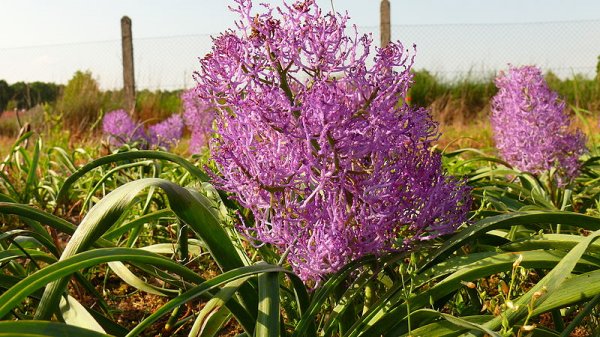Muscari Gardening Tips   
| ||||
|
Muscari is a genus of flowering plants in the family Hyacinthaceae, comprising 40 species. It is native to Eurasia, from the Mediterranean basin, the center and south of Europe, northern Africa, the west, center and south-west of Asia. It is commonly known as Grape Hyacinth. The term muscari comes from Latin word muscus, since the scent is said to be resemble musk. Muscari are a group of bulbuous perennial plants bearing urn-shaped spikes of dense, mostly blue flowers which resembling bunches of grapes in the spring. There are also cultivars producing white flowers. Some species of Muscari are among the first to bloom in spring. They are commonly cultivated in lawns, borders, rock gardens and containers and can be found growing in woodlands and meadows. Muscari are hardy plants and require little care in the summer. Muscari armeniacum is an excellent, hardy bulb for naturalizing under deciduous shrubs. It has narrow mid-green leaves and dense racemes of dark blue, purple, or white flowers in spring. Cultivars include 'Blue Spike', 'Saphir' and 'Early Giant'. Muscari latifolium is an borderline hardy plant bearing dark violet-blue flowers topped by a crown of paler flowers. It is good in containers and remember to protect the plant in winter. Muscari comosum (Tufted Grape Hyacinth, Hairy Muscari, Edible Muscari, or Cipollini) is a herbaceous plant bearing cream-brown flowers topped by a tassel of sterile, violet-blue flowers. It is native to the Mediterranean basin, but spread northwards. It naturalises easily and can become invasive. It is grown as edible plants and is served in Mediterranean countries as cipollini. Muscari botryoides (Common Grape Hyacinth) is a perennial plant bearing white flowers that are closed together, and are almost totally round. The lower flowers are bend towards the ground, while the upper ones are pointing upwards. It is native to the Mediterranean area but it is now common in the warmer areas of Central Europe. M. botryoides 'Album' has dense racemes of fragrant white flowers. Muscari is easy to grow and it prefers full sun, fertile, moisture-retentive but well-drained soil. Propagation is by seed in autumn, and offsets in summer. Muscari armeniacum Author: Fizykaa (Creative Commons Attribution ShareAlike 3.0-unported) Muscari armeniacum Author: Opioła Jerzy (Creative Commons Attribution-Share Alike 2.5 Generic) Muscari botryoides Author: Kurt Stueber (Creative Commons Attribution ShareAlike 3.0) Muscari botryoides 'Album' Author: Aha (Creative Commons Attribution ShareAlike 3.0) Muscari comosum Author: Luis Nunes Alberto (Creative Commons Attribution ShareAlike 3.0-unported)  Muscari comosum 'Plumosum' Author: aha (Creative Commons Attribution ShareAlike 3.0) Muscari racemosum Author: Philipendula (Creative Commons Attribution ShareAlike 3.0) | ||||
|


